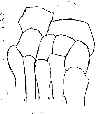- Discussion:
- impediments to reduction:
- incarcerated bony fragments which remain attached to lisfranc ligament;
- entrapped anterior tibial tendon may occur in the case of a laterally dislocated first metatarsal (homolateral);
- key to reduction:
- firm opposition of the lateral border of the medial cuneiform to the second metatarsal which allows healing of lisfranc's ligament;
- first metatarsalcuneiform joint:
- is reduced & stabilized first;
- reduction of this articulation often results in reduction of the 2nd metatarsal cuneiform articulation;
- lateral borders of 1st metatarsal base & medial cuneiform are aligned & 2nd metatarsal base is firmly apposed to lateral border of first cuneiform;
- reduction of frx dislocation of 2nd metatarsal is essential;
- initial reduction can be held together w/ K wires;
- w/ divergent & homolateral types of injury, use 2 transfixion wires;
- one through 5th metatarsal base into cuboid & one through 1st metatarsal into first cuneiform;
- ensure that frx is reduced in saggital plane by matching dorsal margins of these joint surfaces


